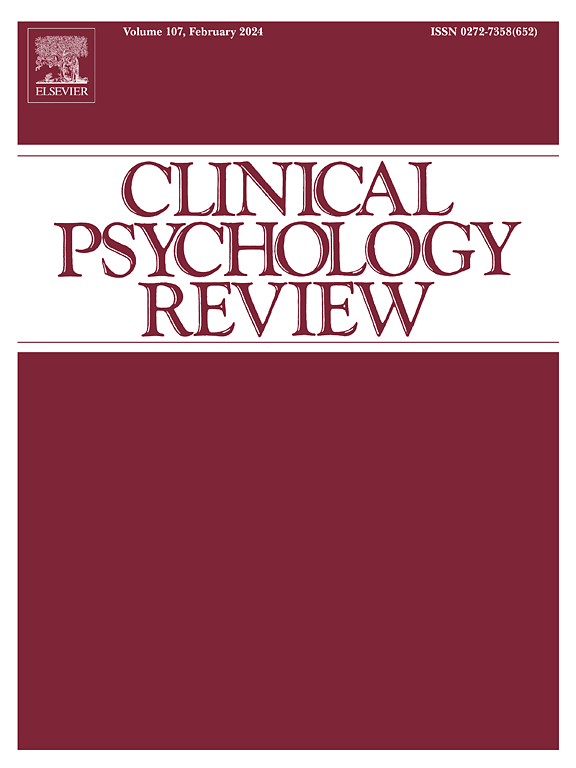Understanding the mechanisms underlying the association between insecure attachment and intimate partner violence (IPV): Meta-analyses using two meta-analytical methods and a systematic review of mediators
IF 12.2
1区 心理学
Q1 PSYCHOLOGY, CLINICAL
引用次数: 0
Abstract
Little is known about why insecure attachment is related to greater perpetration and victimization of intimate partner violence (IPV). Many studies have examined the underlying mechanisms, but no studies have integrated them. The present article aimed to systematically identify and quantify the magnitude of the mediators between anxious and avoidant attachment and IPV perpetration and victimization. We used two meta-analytic methods (two-stage structural equation modelling and multi-level meta-analyses) to accomplish this goal. After screening 5087 records, 63 eligible studies were identified. The mediators were reviewed using the framework of the I3 model. We meta-analyzed seven categories of mediators, including: 1) jealousy, anger, distrust, and perceived partner's infidelity, 2) dysfunctional beliefs, 3) maladaptive personality traits, 4) relationship dissatisfaction, 5) dominance and need for control, 6) destructive communication, and 7) emotion dysregulation. Results showed that interpersonal instigating (jealousy, anger, distrust, and perceived partner's infidelity), interpersonal impelling (relationship dissatisfaction, dominance and need for control, destructive communication), and personal disinhibiting (emotion dysregulation) factors significantly mediated the attachment-IPV relationships. The indirect effects of most instigating, impelling, and disinhibiting factors had small effect sizes, but interpersonal impelling factors such as dominance/need for control and relationship dissatisfaction had medium effect sizes in the anxiety-IPV and avoidance-IPV links respectively. Moreover, some mediators between avoidance and IPV were significant without having significant direct effects. An additional 26 mediators were presented in the Systematic Review section. The findings suggest IPV interventions should consider addressing attachment insecurity along with the relevant mediators, especially interpersonal impellance for avoidant attachment.
了解不安全依恋与亲密伴侣暴力(IPV)之间关联的潜在机制:使用两种元分析方法的元分析和对中介的系统回顾
为什么不安全的依恋与亲密伴侣暴力(IPV)的更大的犯罪和受害有关,人们知之甚少。许多研究已经检查了潜在的机制,但没有研究将它们整合起来。本文旨在系统地识别和量化焦虑型和回避型依恋与IPV犯罪和受害之间的中介因子的大小。我们使用了两种元分析方法(两阶段结构方程模型和多层次元分析)来实现这一目标。在筛选5087份记录后,确定了63份符合条件的研究。使用I3模型的框架对中介进行了审查。我们元分析了七种类型的中介因素,包括:1)嫉妒、愤怒、不信任和感知伴侣的不忠;2)功能失调的信念;3)适应不良的人格特征;4)关系不满;5)支配和控制需求;6)破坏性沟通;7)情绪失调。结果表明,人际唆使(嫉妒、愤怒、不信任和感知伴侣不忠)、人际强迫(关系不满、支配和控制需求、破坏性沟通)和个人解除抑制(情绪失调)因素显著调节依恋- ipv关系。在焦虑- ipv和回避- ipv环节中,多数诱导因素、驱使因素和去抑制因素的间接效应均具有较小的效应量,而人际驱动因素如支配/控制需求和关系不满的间接效应量分别具有中等效应量。此外,回避和IPV之间的一些中介因素是显著的,但没有显著的直接影响。系统审查部分还介绍了另外26种介质。研究结果表明,IPV干预应考虑解决依恋不安全感以及相关的中介因素,特别是回避型依恋的人际冲动。
本文章由计算机程序翻译,如有差异,请以英文原文为准。
求助全文
约1分钟内获得全文
求助全文
来源期刊

Clinical Psychology Review
PSYCHOLOGY, CLINICAL-
CiteScore
23.10
自引率
1.60%
发文量
65
期刊介绍:
Clinical Psychology Review serves as a platform for substantial reviews addressing pertinent topics in clinical psychology. Encompassing a spectrum of issues, from psychopathology to behavior therapy, cognition to cognitive therapies, behavioral medicine to community mental health, assessment, and child development, the journal seeks cutting-edge papers that significantly contribute to advancing the science and/or practice of clinical psychology.
While maintaining a primary focus on topics directly related to clinical psychology, the journal occasionally features reviews on psychophysiology, learning therapy, experimental psychopathology, and social psychology, provided they demonstrate a clear connection to research or practice in clinical psychology. Integrative literature reviews and summaries of innovative ongoing clinical research programs find a place within its pages. However, reports on individual research studies and theoretical treatises or clinical guides lacking an empirical base are deemed inappropriate for publication.
 求助内容:
求助内容: 应助结果提醒方式:
应助结果提醒方式:


